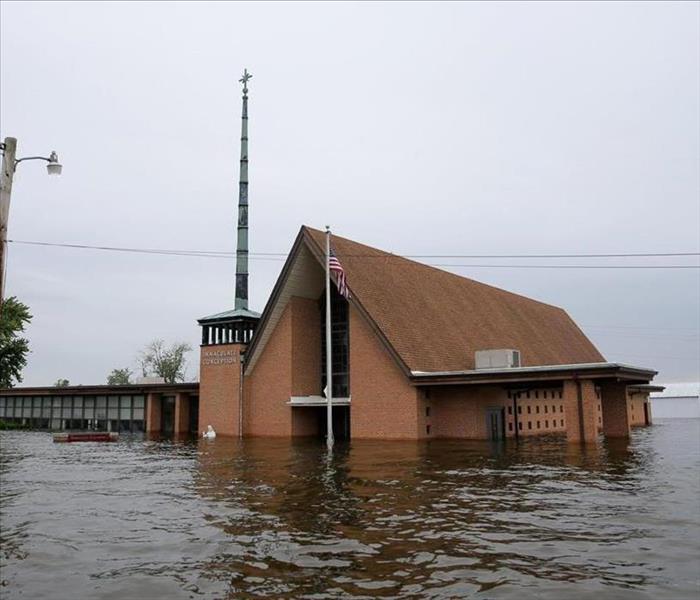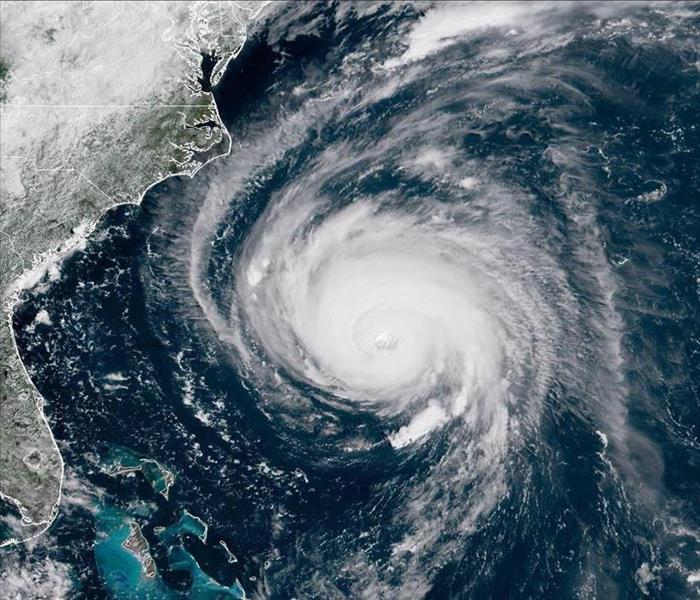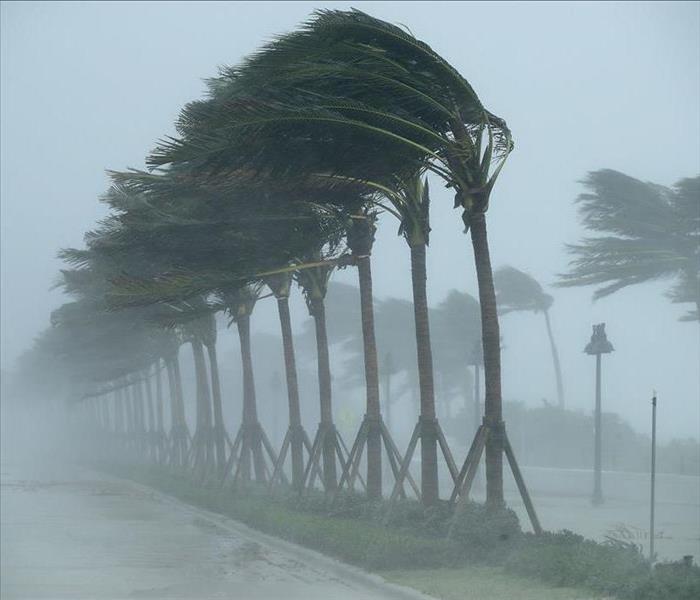Recent Storm Damage Posts
SERVPRO is Here to Help when a Tornado Damages Your Saline County Home
6/6/2023 (Permalink)
For every homeowner in Saline County and the surrounding regions, tornadoes are a real risk. Unfortunately, these storm systems can cause severe damage to your home in a very short period and there is very little that anyone can do to prevent the destruction from these disasters. However, recovering from tornado damage is not something that you have to face alone.
No one can know how much damage will be done until after the storm has passed, as these storms vary greatly in size and intensity. The strong winds, swirling trapped debris, and fallen trees put the exterior of your home at risk for severe damage. Making the roof, siding, and windows of your Saline County home most vulnerable.
If these areas of your home remain open or exposed to the elements, compounding risks may arise. External damage may create structural weaknesses or vulnerable points that can give way later on. Weakened roofing and open siding make flooding a constant threat and leave the contents of your home vulnerable to theft. Board up, tarping, or pack out services may be necessary to mitigate further damage until reconstruction can begin.
SERVPRO of Saline County and Hot Springs professional technicians can help you to preserve your home and the things inside it that you hold dear. Your contents can be packed up and brought to our secure facility to be cleaned and stored until your home’s restoration is complete. We can also provide tarping and board up services to keep rain and unwanted elements from entering your home. Our reconstruction team can also assist in the rebuilding efforts and help bring your home back to pre-storm conditions.
While you may never be completely prepared for the destructive nature of a tornado, SERVPRO of Saline County and Hot Springs is always ready to respond and here to help. No matter what day or time, we are available 24/7. For professional restoration, tarping, board up, and pack out services, call SERVPRO of Saline County and Hot Springs at (501) 409-6557.
The Stages and Categories of Hurricanes
8/22/2022 (Permalink)
During Hurricane Season, you tend to hear TV meteorologists talking about different terms and categories to classify the storm. What do they actually mean?
Where do hurricanes actually begin? As a storm builds from a thunderstorm to a hurricane, it passes through 4 distinct stages:
Tropical Disturbance: a mass of thunderstorms that have wind speeds of less than 23 mph.
Tropical Depression: consistent wind speeds of 23-39 mph and a circulation of wind in the center of the thunderstorm mass is detected.
Tropical Storm: forms when the maximum sustained winds have intensified to 39-73 mph. Storms are typically given a name at this stage and are characterized by problems caused from very heavy rainfall.
Hurricane: finally forms when surface pressures continue to drop, and winds reach 74 mph. There is now a clear and definite rotation around a calm center, or eye.
Hurricanes have their own categories which are defined by the Saffir Simpson Hurricane Wind Scale:
Category 1: Winds 74 to 95 mph (Minor damage)
Category 2: Winds 96 to 110 mph (Extensive damage — Can uproot trees and break windows)
Category 3: Winds 111 to 129 mph (Devastating — Can break windows and doors)
Category 4: Winds 130 to 156 mph (Catastrophic damage — Can tear off roofs)
Category 5: Winds 157 mph or higher (Can level houses and destroy buildings)
This scale only estimates property damage that could occur with the maximum sustained wind speed of a particular hurricane; it does not take into account the potential for other dangerous events that often accompany hurricanes, like tornadoes, flooding, and storm surge.
Calm Waters
8/9/2022 (Permalink)
Before the 2022 Hurricane Season started, the NOAA predicted an above-average season to rival the extremely active 2021 season. The Gulf Coast and other areas braced themselves for an influx of tropical weather, and then...
Nothing happened. There have only been 3 named storms since the beginning of the season in June.
Many areas in the Gulf were affected by drought conditions through the spring and summer months, and the Hurricane Outlook was officially downgraded at the beginning of August.
So, is everything all clear? Not exactly.
Approaching mid-August, there are some disturbances and tropical waves showing up on the radar. These could eventually turn into named storms that affect the Gulf Coast and surrounding areas. We're heading into the peak of Hurricane Season, and anything could happen.
If it does?
We'll be there. SERVPRO of Saline County and Hot Springs have assisted our national Storm Teams in areas affected by strong hurricanes. We're ready to do it again.
We're always here to help.
The 2022 Atlantic Hurricane Season
6/14/2022 (Permalink)
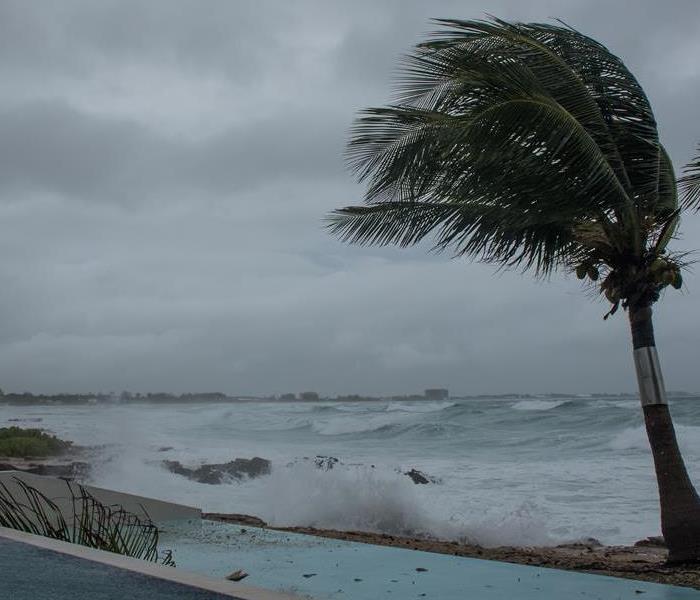 NOAA predicts 3 to 6 major hurricanes for the 2022 season.
NOAA predicts 3 to 6 major hurricanes for the 2022 season.
We've made it to the 2022 Hurricane Season, and from what the NOAA predicts, it may be a doozy. Due to the ongoing La Niña weather pattern, the Atlantic hurricane forecast is much higher than average for the seventh year in a row.
What is La Niña?
Essentially, it's a weather pattern in the Pacific Ocean featuring cooler ocean temperatures. As these conditions travel, it generally results in colder winters and heavier snow. This gives way to above average temperatures in the Southeastern US as the seasons change. It also brings a greater likelihood for tornadoes and hurricanes.
We just made it through a particularly intense spring tornado season, featuring monthly tornadic totals well above what they were in 2021. As the tornado season slows, attention turns to the Caribbean and the Gulf of Mexico. La Niña years tend to affect the Atlantic hurricane cycles.
The Gulf Coast was affected by several Category 3 (or higher) hurricanes over the past few years. It can be unsettling, wondering what lies ahead for friends and family who live in the area.
We keep a close eye on the weather, too. SERVPRO is ready to roll when the Gulf Coast experiences a strike from a hurricane. Our Storm Teams immediately dispatches to the area to get the water out and mitigate the damage.
We're always here to help.
Tornado Season 2022
5/2/2022 (Permalink)
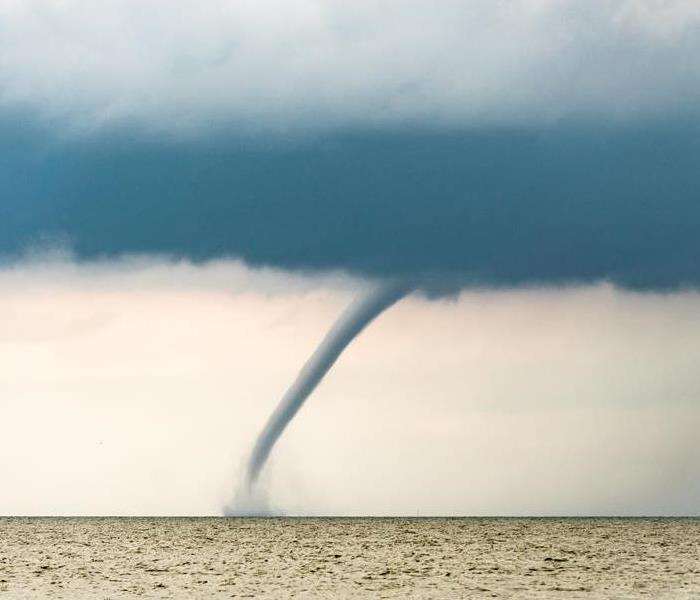 Stay safe this tornado season!
Stay safe this tornado season!
The 2022 Tornado Season has already been incredibly active in the south, and as we enter May, there doesn't appear to be many signs of slowing down. May has traditionally been the month with the most tornadoes, as the tornado season hits its peak.
That statement hits a bit different when you look at where our tornado season stands when compared to last year.
- March 2021 - 139 tornadoes recorded in the United States
- April 2021 - 79 tornadoes recorded in the United States
- May 2021 - 259 tornadoes recorded in the United States
Here's where we are as of May 1st:
- March 2022 - 226 tornadoes recorded in the United States
- April 2022 - 193 tornadoes recorded in the United States
- May 2022 - ???
You see the cause for concern.
People who have spent at least a few years in the South have an idea of what to do when a tornado watch or warning is issued for their area. But a refresher never hurt anyone, especially when the population has grown so much over the past few years!
- Many properties actually have storm shelters. These are ideal, but if that isn't an option, go to an interior room of the home. Bathrooms without windows tend to fare a bit better than rooms with outside walls.
- Keep cell phones charged to receive weather warnings and in the event of a power outage.
- Have a plan for yourself and your family in the event of a tornado. Don't forget your pets!
Tornadoes are a part of southern life during the spring. Should your home experience water damage from a tornado or wind event, SERVPRO of Saline County and SERVPRO of Hot Springs are always here to help.
Give us a call at 501-776-2222.
When a Storm Causes a Prolonged Electrical Outage
3/9/2022 (Permalink)
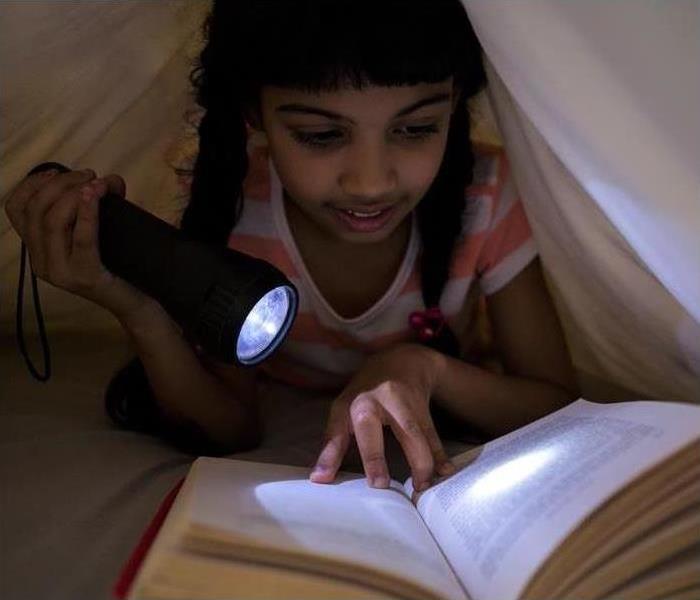 Keep flashlights on hand in case of an electrical outage!
Keep flashlights on hand in case of an electrical outage!
There is often advanced notice when a winter storm approaches your area. Shoppers make a run on grocery stores and buy up all the milk and bread and plan to settle in their warm homes to ride out the storm. The plan often goes off without a problem, but that isn't always the case.
Arkansas tends to experience an ice storm event every few years that causes issues. Freezing rain and sleet topple trees into power lines, and then the neighborhood goes dark. Power companies generally have someone on the scene quickly, but during a major ice or snow event, the power companies could be overwhelmed. Now you're looking at staying in the dark for several days in a row. What should you do? More importantly, what SHOULDN'T you do?
Once the lights go out, some people immediately round up all the candles in their homes and light them all over the house. This is a bad idea, especially if you live in a home with children or pets. Even if you don't, it's never a good idea to leave a candle burning unattended. Flashlights are a much better option! Make sure you're stocked up on batteries.
Prolonged power outages also affect the food supply. A freezer full of food should last for 48 hours, and a half-full one should last for 24 hours. Highly perishable food in the refrigerator should last for around 4 hours. If your house has a gas stove, it should still work, as would a backyard gas grill. Remember – never grill inside! It could lead to a fatal build-up of carbon monoxide. Any food that isn't consumed within two hours should be tossed to avoid spoilage. Many homeowner insurance policies cover food loss in the event of an outage, so you should double-check your policy!
Should you have access to a generator, be careful how you use it. It is recommended to operate it at least 20 feet from the house while ensuring that the exhaust is directed away from doors and windows to prevent a potentially deadly build-up of carbon monoxide. If you do not have a generator, make sure to unplug all of the large appliances in the home, and some of the smaller ones to prevent an electrical surge once the power is restored.
Winter storms often lead to frozen pipes, especially in homes with no electricity. Should you have water damage from a winter storm, we're always here to help. Give us a call today at 501-776-2222. SERVPRO of Saline County and SERVPRO of Hot Springs are fast to the scene to make it “Like it never even happened.”
Remembering the 2021 Snowpocalypse
1/28/2022 (Permalink)
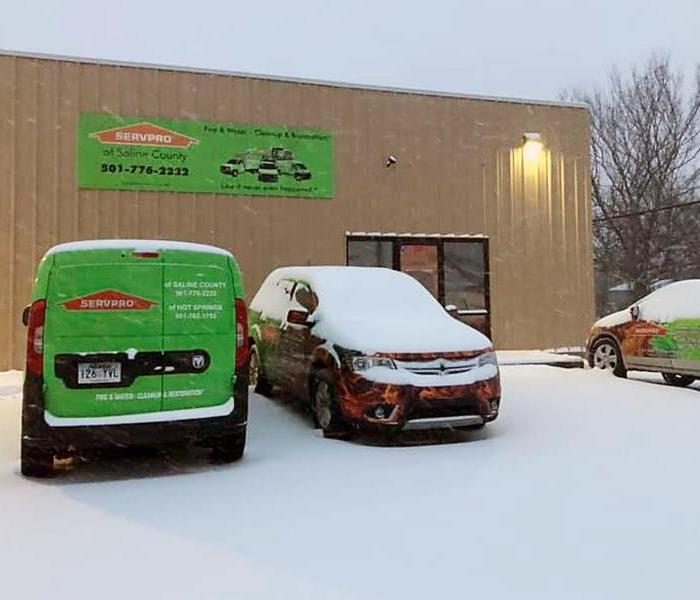 Will we see this in 2022?
Will we see this in 2022?
If you're on social media, your Facebook memories should soon be full of photos of Snowmageddon 2021. Doesn't really feel like it's been a year, does it? When the forecast mentioned snow, no one in Central Arkansas really expected the almost TWO FEET that we got. It was a massive storm that shut down most of the state for days.
Before it snowed, we'd experienced below-freezing temperatures for several days in a row. This resulted in a lot of people finding out what could happen when their pipes freeze.
It was a very, very busy time for SERVPRO of Saline County and SERVPRO of Hot Springs!
But we can handle it!
When a storm hits a region of the country, SERVPRO is Faster to Any Size Disaster. We have designated Storm Teams ready to mobilize to the affected areas so we can make it "Like it never even happened."
We're always here to help.
The Danger of Nighttime Tornadoes
8/23/2021 (Permalink)
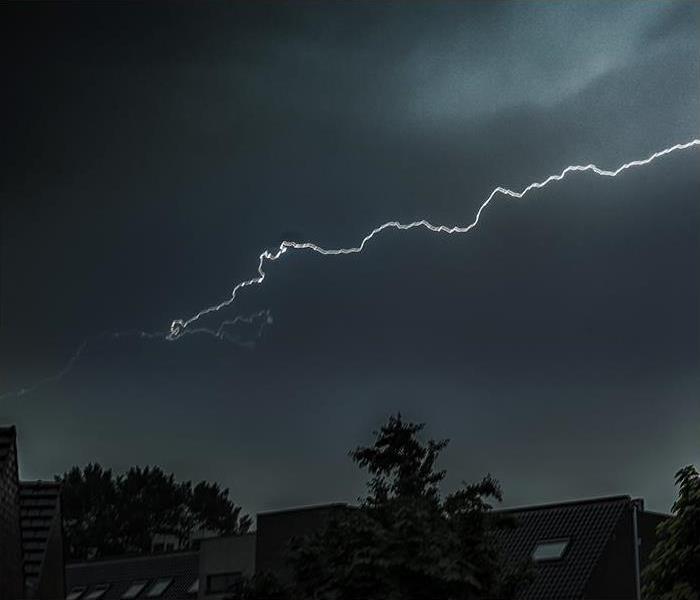 The worst types of tornadoes come out after dark.
The worst types of tornadoes come out after dark.
Tornadoes are one of the most unpredictable types of storms. Their intensity and strength often expand without warning, making them dangerous at any time of day. But an entirely new level of danger is involved when a tornado quickly forms and strikes at night, especially in the overnight hours. Tornadoes that strike between 9 pm to 6 am CST are known as Nocturnal Tornadoes. These tornadoes are more than twice as likely to be deadly.
There are many reasons that nocturnal tornadoes are much more dangerous than those that occur in the daytime. The most obvious reason is that it is next to impossible to see a tornado at night. Later hours mean that fewer storm spotters are on the road, which makes it more difficult for meteorologists to confirm that a tornado has touched the ground. More people are likely asleep during the overnight hours, leaving them unaware that a tornado is in their area. Tornado sirens usually go off during a storm, but the siren could be missed depending on how far away someone lives from the siren range. A sound sleeper may not wake up at all, which could be dangerous if they live in a structure like a mobile home, which cannot withstand high tornadic winds.
Unfortunately, nocturnal tornadoes have a higher chance of happening in the South. The states with the highest percentage of tornadoes that strike at night are Tennessee (46%), Arkansas (43%), Kentucky (42%), and Mississippi (39%).
The South is vulnerable to nighttime tornadoes for several reasons. Southern states typically have mild winters, which means a tornado can strike at any time of the year, which can be dangerous because once the time changes in the fall, it gets dark much earlier. Southern states also have a much higher instance of residents living in mobile homes. These overlapping factors combine to form a very real threat to those who call the South home. Luckily there are some tools to assist with tornado alerts, many of them are available on your mobile phone. The National Weather Service sends wireless emergency alerts, as do many weather apps available for both iPhone and Android. It is always recommended to purchase an NOAA weather radio, which alerts with a loud tone, followed by the details of the warning. This might be enough to startle a heavy sleeper awake and give them enough time to get to safety.
Tornadoes are unpredictable and potentially devastating. Should your home suffer a loss from a tornado, SERVPRO of Saline County and SERVPRO of Hot Springs are always here to help. Give us a call at 501-776-2222 to discuss your needs, 24/7. We'll make it "Like it never even happened."
How Are Hurricanes Named?
8/10/2021 (Permalink)
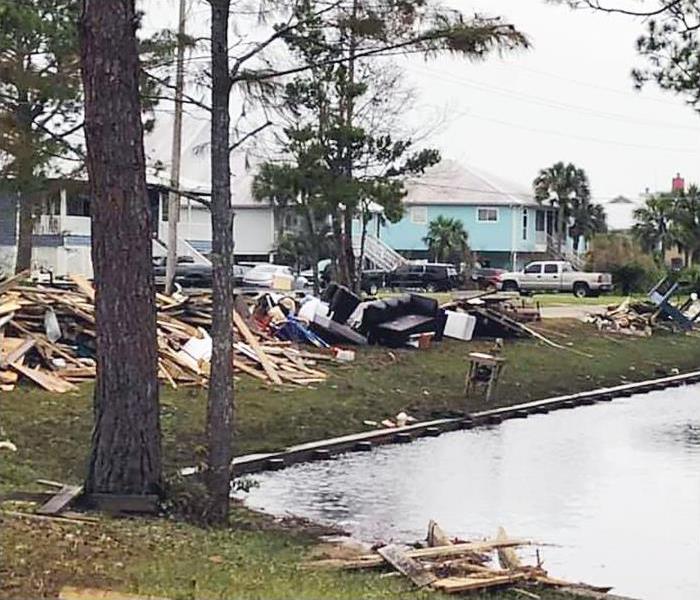 The name "Sally" was retired in 2020, after Hurricane Sally devastated Gulf Shores, AL.
The name "Sally" was retired in 2020, after Hurricane Sally devastated Gulf Shores, AL.
Hundreds of years ago, in the early days of weather forecasting, many hurricanes were named after saints. As years passed, a hurricane would hit on the same saint's day as a previous hurricane. For example, San Felipe (the first) and San Felipe (the second) struck Puerto Rico on September 13, 1876, and 1928. Hurricane season hits its peak between mid-August and mid-October of each year, so this naming process could get very confusing, very quickly! During active seasons, there could be several tropical storms or hurricanes forming in the Atlantic at the same time. The United States began giving short names to hurricanes in 1953. These names were exclusively female until 1978 when male names were finally added into the rotation. The World Meteorological Organization maintains the list of hurricane names.
Ever thought you've heard a storm name from the past? You probably have! The official storm name list rotates and recycles itself every six years. Every name doesn't recycle, however. Hurricanes that were very costly or devastating have their names retired for sensitivity. No one would want another Hurricane Katrina or Hurricane Betsy!
The 2021 Atlantic Hurricane Season will begin a new naming tradition. Last year's season was so extremely active, more than 21 named storms occurred, so once the main list of names was used, meteorologists shifted to the Greek alphabet, as in years past. But 2020 Greek-named storms contained two monsters whose names were retired -- Eta and Iota. Because of this, the World Meteorological Organization produced an alternate list of names to back up the main list of storm names.
It's always fun to look at the list and see if any of the names correspond with yourself or your friends and family, but as a rule, hurricanes are extremely strong storms that can wreak havoc once they make landfall. SERVPRO of Saline County and SERVPRO of Hot Springs stay alert during hurricane season and can assemble a traveling storm team at a moment's notice to help those affected by the devastation.
We're always here to help.
The Danger of Flash Floods
6/16/2021 (Permalink)
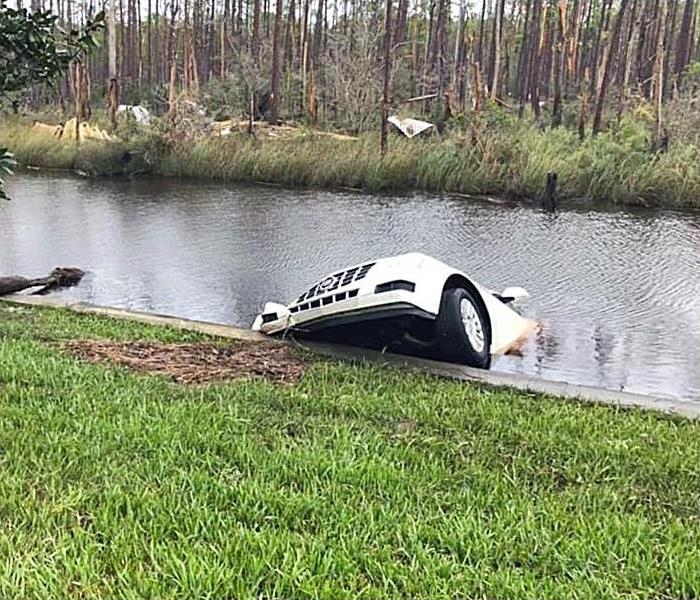 It only takes a foot of floodwater to sweep away a vehicle during a flash flood.
It only takes a foot of floodwater to sweep away a vehicle during a flash flood.
When an area receives an overabundance of rain in a short period of time, the likelihood of a flash flooding event increases. Flash floods are dangerous because they move so quickly. According to the National Weather Service, flash floods are the number one cause of weather-related deaths in the United States. The majority of those deaths are automobile-related. Never drive onto a flooded roadway because you have no way of knowing the depth of the water or how fast it is moving. A car can be swept away before the driver fully realizes the extent of the danger.
A flash flood can happen when the ground is so saturated from heavy rainfall, it cannot absorb any more, so the water begins to rise. This makes cities and other densely populated areas at a higher risk for flash floods. More of the land is covered by concrete, roadways, buildings, and the like, so there is less natural ground to absorb the water. Storm drains often become clogged by debris, causing an overflow into the streets and buildings nearby. Low areas become extremely dangerous in situations like this.
So what do you do if there is a Flash Flood Warning for your location? Most importantly, seek higher ground. If you are instructed to evacuate, do so immediately. Flash floods can bring rapidly rising water, so seconds count. Have a disaster plan in place for your family so you know what to do and where to go. Never try to walk or drive into floodwaters. It only takes six inches of water to knock you down and sweep you away. A foot of floodwater can do the same to a vehicle.
Should you find your home or business damaged due to a flash flood, SERVPRO of Saline County and SERVPRO of Hot Springs is here to help. Give us a call at 501-776-2222. We're available 24/7 and will work with you to make it "Like it never even happened."
The 2021 Atlantic Hurricane Season
5/14/2021 (Permalink)
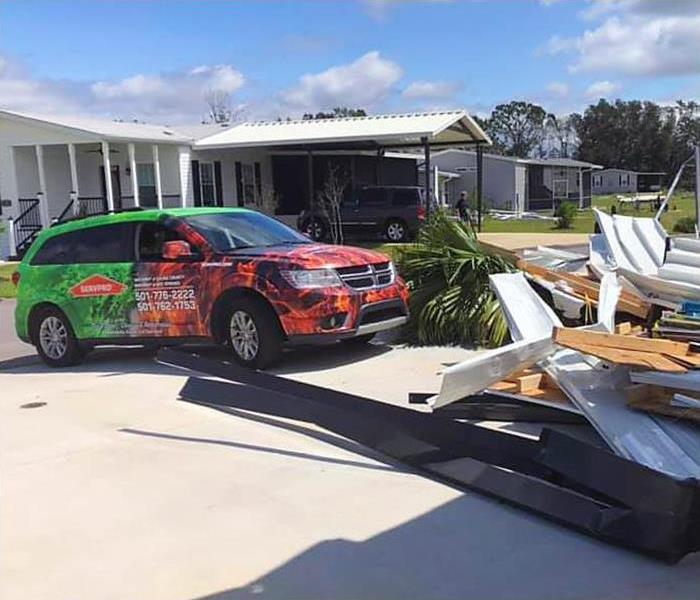 Our Storm Team made a trip to help out in Gulf Shores, AL in September 2020 after Hurricane Sally devastated the region.
Our Storm Team made a trip to help out in Gulf Shores, AL in September 2020 after Hurricane Sally devastated the region.
2020 was a record-setting year for Atlantic hurricanes. There were a total of thirty named storms, with thirteen of them becoming hurricanes. Of those thirteen hurricanes, six were designated as major hurricanes (where the wind speed was greater than 111mph). It was a very active season, and most folks who live in areas where hurricanes could strike were very happy to see it go. The time in-between seems fleeting because the first day of the 2021 Atlantic Hurricane Season is June 1st, 2021. The coast isn't clear until June, because the past six hurricane seasons actually began earlier than June 1st. Beginning this year, the National Hurricane Center plans to issue tropical weather outlooks for the Atlantic starting May 15, 2021.
The intensity of a particular year's hurricane season varies from year to year. Some years experience a relatively mild hurricane season, which officially runs from June 1st through November 30th. Unfortunately, the probability of the 2021 hurricane season being uneventful is extremely low. Experts are actually predicting an above-average probability for major hurricanes making landfall this year.
While tropical weather doesn't usually make it to Central Arkansas, SERVPRO of Saline County and SERVPRO of Hot Springs keep an eye on potential hurricanes and stand ready to assemble a storm team to go to the affected area and assist if it becomes necessary. We're always here to help.
When a Storm Causes a Prolonged Electrical Outage
3/12/2021 (Permalink)
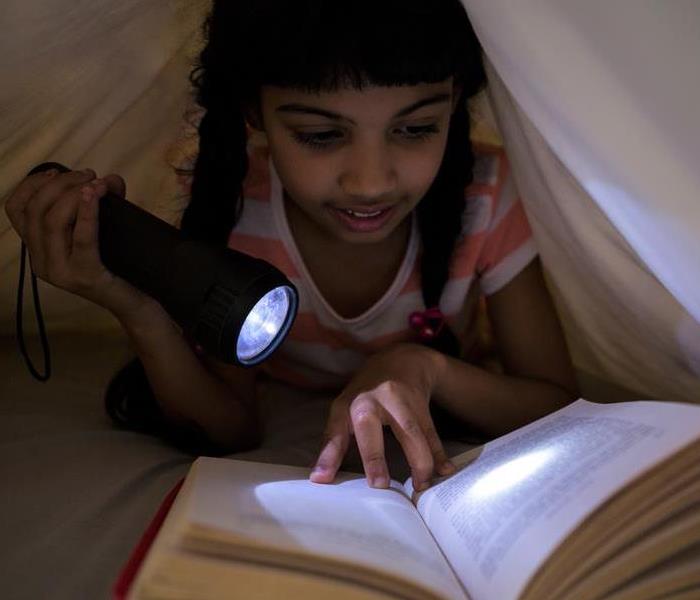 Keep flashlights on hand in case of an electrical outage
Keep flashlights on hand in case of an electrical outage
There is often advanced notice when a winter storm approaches your area. Shoppers make a run on grocery stores and buy up all the milk and bread and plan to settle in their warm homes to ride out the storm. The plan often goes off without a problem, but that isn't always the case.
Arkansas tends to experience an ice storm event every few years that causes issues. Freezing rain and sleet topple trees into power lines, and then the neighborhood goes dark. Power companies generally have someone on the scene quickly, but during a major ice or snow event, the power companies could be overwhelmed. Now you're looking at staying in the dark for several days in a row. What should you do? More importantly, what SHOULDN'T you do?
Once the lights go out, some people immediately round up all the candles in their homes and light them all over the house. This is a bad idea, especially if you live in a home with children or pets. Even if you don't, it's never a good idea to leave a candle burning unattended. Flashlights are a much better option! Make sure you're stocked up on batteries.
Prolonged power outages also affect the food supply. A freezer full of food should last for 48 hours, and a half-full one should last for 24 hours. Highly perishable food in the refrigerator should last for around 4 hours. If your house has a gas stove, it should still work, as would a backyard gas grill. Remember – never grill inside! It could lead to a fatal build-up of carbon monoxide. Any food that isn't consumed within two hours should be tossed to avoid spoilage. Many homeowner insurance policies cover food loss in the event of an outage, so you should double-check your policy!
Should you have access to a generator, be careful how you use it. It is recommended to operate it at least 20 feet from the house while ensuring that the exhaust is directed away from doors and windows to prevent a potentially deadly build-up of carbon monoxide. If you do not have a generator, make sure to unplug all of the large appliances in the home, and some of the smaller ones to prevent an electrical surge once the power is restored.
Winter storms often lead to frozen pipes, especially in homes with no electricity. Should you have water damage from a winter storm, we're always here to help. Give us a call today at 501-776-2222. SERVPRO of Saline County and SERVPRO of Hot Springs are fast to the scene to make it “Like it never even happened.”
Why Do Pipes Freeze?
3/10/2021 (Permalink)
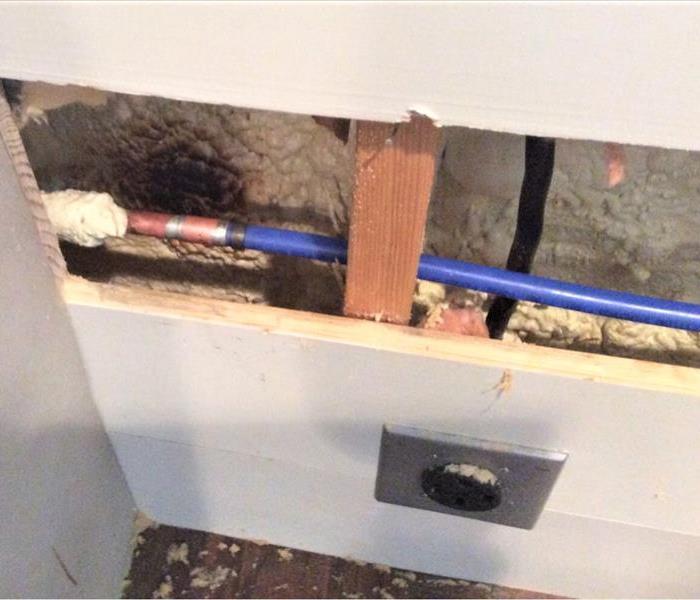 Frozen pipes can cause serious damage to a home.
Frozen pipes can cause serious damage to a home.
Frozen pipes can wreak havoc on residential property; it’s one of the biggest causes of water damage to a home. Southern homeowners are sometimes caught unprepared since days-long stretches of below-freezing temperatures are a rarity in Saline County and Hot Springs.
It is important to cover your pipes if the forecast calls for freezing temperatures or winter storms. Ice expands and overwhelms the pipes, causing them to burst. This could cause serious issues inside of your home. It’s always a good idea to leave your cabinets open so heat can reach the pipes when freezing weather is expected.
Water pipes generally freeze when the temperature is 20 degrees or below. It isn’t instantaneous; it could take up to six hours for pipes to freeze. Keep water moving through the pipes to prevent freezing. How much should they drip? Try to make sure your faucet is dripping at least five drops per minute.
Water damage from burst pipes is always unfortunate, but SERVPRO of Saline County and SERVPRO of Hot Springs are ready to help. Should your frozen pipes cause water damage due to a winter storm, we've got you covered. Give us a call today at 501-776-2222 and we can make it “Like it never even happened.”
We're always here to help.
What Every Business Owner Should Know About Black Water Flooding
9/16/2020 (Permalink)
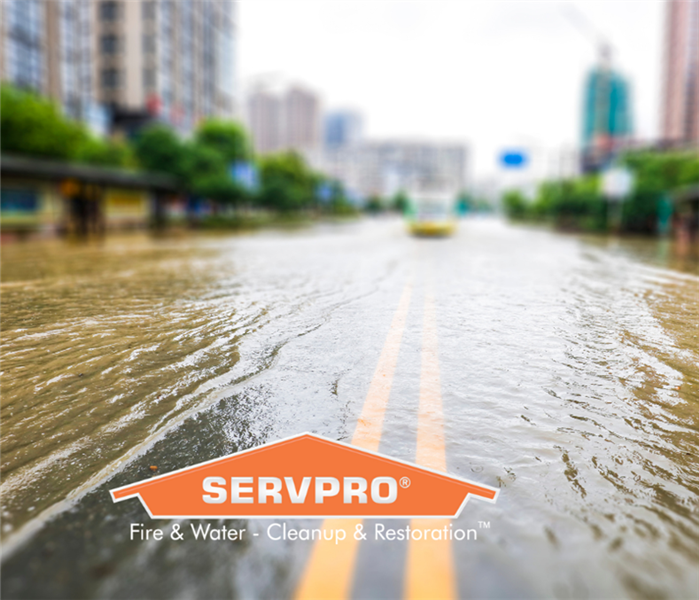 When flood waters rise, SERVPRO can help!
When flood waters rise, SERVPRO can help!
Flooding is a potential risk for business owners everywhere.
If your commercial property in Hot Springs, AR, is affected by flood water, you should be aware that this water could be very dangerous. Luckily, an emergency restoration specialist can determine what type of water you’re dealing with and make an action plan to safely clean and restore your property.
How Is Water From a Flood Classified?
Water from a flood is classified into three categories, based on its source and contents.
- Category One is “clean” and does not pose a health risk.
- Category Two is “gray” and contains some contaminants.
- Category Three is “black” and is heavily contaminated.
Water classified as black presents a high risk of hazard to both humans and animals. Because of the possibility of illness or death, any contact with this water should be avoided.
What Is Black Water?
This category of water likely contains human or animal waste, along with other harmful components, such as bacteria, viruses, mold and fungi. The flood water can come from sewage backup, overflowing toilets or storms.
Levels of Black Water Damage:
Water from flooding that has been categorized as black can be further classified into sub-levels. This designation assists professionals in deciding on the best course of action for sanitation and restoration.
- Level I damage is limited. The water originates inside the building and usually only affects a small space. Porous materials are not contaminated, and there is no structural penetration.
- Level II damage signifies greater contamination in a larger space. While still originating inside the building, porous materials are affected, and the structure should be closely inspected.
- Level III damage presents the highest degree of contamination. This water originates outside the building and can come from sewage lines, septic tanks or storm damage.
Flood water can cause tremendous damage to your property, along with health and safety risks. When water is present in your building, avoid any contact, and wait for the professionals to assess the situation and manage the sanitation and restoration process.
Flood and Fire Interrelationships
9/16/2020 (Permalink)
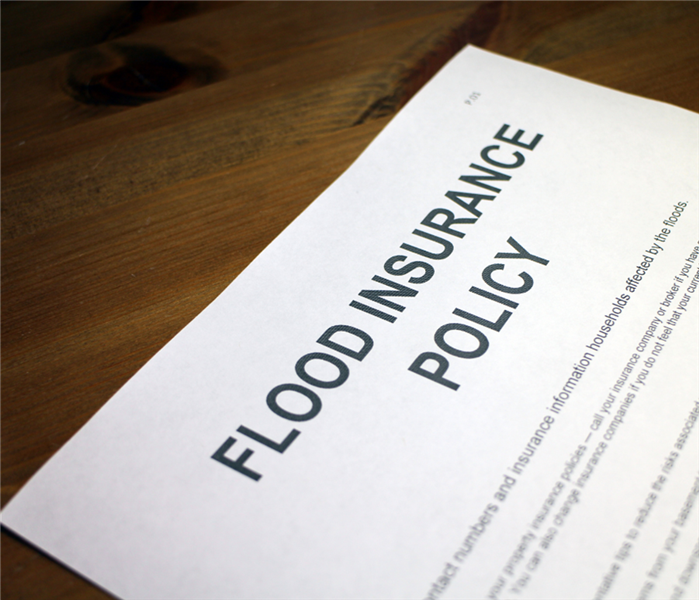 How does your flood policy relate to your fire damage coverage?
How does your flood policy relate to your fire damage coverage?
Many homeowners don’t know that their typical home insurance policy doesn’t cover flooding.
Read on to understand how FEMA NFIP policies and guidelines can protect your property in the event of a natural disaster.
Why Be Concerned?
Wildfire damage isn’t just a huge economic burden in its own right—it also exacerbates local flooding problems. This is because the natural equilibrium is disrupted after vegetation burns. Since this first line of defense against erosion no longer exists, water continues to move through the landscape. Instead of being wicked into the soil and the trees, the water flows to lower elevations and carries ash and mud along with it.
What Can I Do?
FEMA NFIP, which is a National Flood Insurance Program, advises that most homeowners purchase an additional flood insurance policy if they are in any kind of wildfire zone, even if they are otherwise at low risk of flooding damage. Since most policies do not go into effect until around a month after the initial purchase, planning ahead is a necessity. Allow yourself the extra time to guarantee that you’re getting a good deal.
Are There Other Precautions?
Emergency services cannot always make it to the scene of a flood or fire immediately. If you suspect severe fires or storms are incoming, be sure that you have food and water on hand to last for a few days. It may also be helpful to devise an evacuation plan. Seal important documents away in a fire- and flood-proof safe, and take an inventory of any critical or valuable belongings so that insurance adjusters can assess your claim after the disaster.
With the appropriate forethought and know-how, homeowners in Arkansas, can protect themselves against the ravages of the elements, even in fire-prone areas. Just remember to follow FEMA NFIP guidelines and have the contact information of a qualified fire and flood cleanup professional at the ready.
3 Tips for Sump Pump Maintenance
9/16/2020 (Permalink)
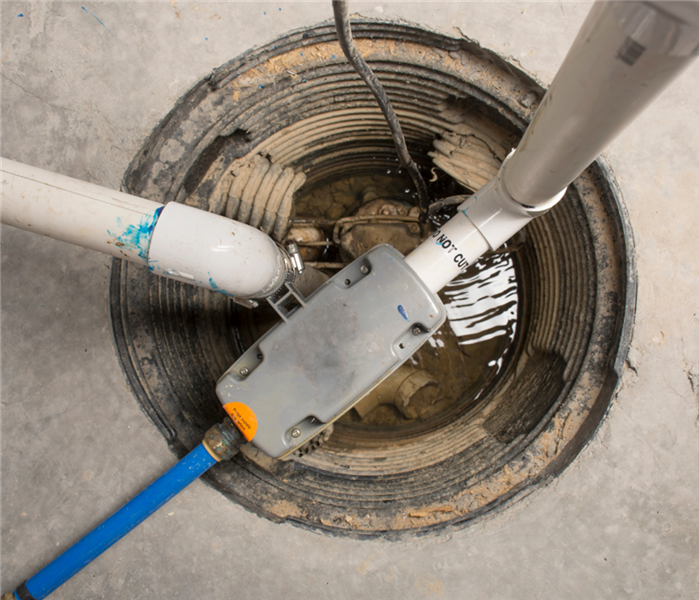 It is important to keep your sump pump properly maintained to prevent water damage.
It is important to keep your sump pump properly maintained to prevent water damage.
If you have a sump pump in your Piney, AR home, then you may already know the dangers flooding can present to your property.
Fortunately, performing regular maintenance on your pump can help it stay in working order, which in turn can help prevent water damage.
Always Follow the Manufacturer's Recommended Use Instructions
Many water damage restoration companies recommend the pumps as a flood prevention method. When performing pump maintenance, it's important to always follow your manufacturer's recommended instructions. This includes making sure the cord is in good repair, and that the unit is plugged into a ground fault circuit interrupter. This can help ensure your pump correctly performs the intended job for its lifespan.
Regularly Check For, and Clean Out Any Debris
Another important step for maintaining your sump pump is to ensure the pump, the vent, the discharge pipe, and its intake screen remain clear of debris. Common clogs can be comprised of dirt, gravel, leaves, sticks, and other materials that may have gotten into the water. A clogged unit often has to work harder to do its job and is at greater risk of malfunction.
Perform Routine Maintenance on Your Pump
Regularly looking over your pump for any maintenance needs can help you prevent larger problems such as clogs and unit malfunction. Take the time to inspect the cord, and clear away any debris that could be a problem. If you find your pump is malfunctioning it's best to call a professional to service the unit.
Remember, maintaining your sump pump can help prevent costly water damage to your home. Always follow the manufacturer's instructions for how to use, plug-in and clean your pump. Keeping your pump clear of debris can also help prevent clogs which may damage the unit. It's important to check for these things on a regular basis. If you have any questions, a professional might be able to help.
Business Continuity Planning - Risk Management Tips
9/16/2020 (Permalink)
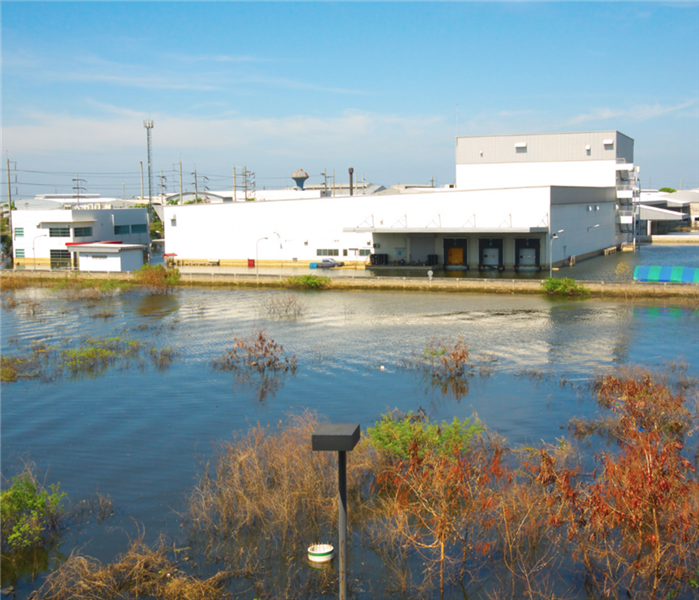 Do you have a Business Continuity Plan in place?
Do you have a Business Continuity Plan in place?
Business continuity planning is the process of developing a practical guide for how your business will recover or restore critical business activities within a given timeframe after a crisis or storm damage in Hot Springs, AR.
The resulting plan is called a business continuity plan or BCP. When developing your BCP, you should include actions to rehearse, maintain, and review your plan to make sure it meets the needs of your company over time.
Business Impact Analysis
Your business impact analysis identifies the following:
- The effect of different external and internal impacts upon the various parts of your business in times of crisis
- The time that your business can survive without undertaking critical activities
- The tasks that will be required to manage the initial phase of an incident and the individuals responsible for each task
Types of Plans
Depending on the size and nature of your business, and the business planning specialists, you may choose to have separate risk management, business impact analysis, response, and recovery plans. For a small business, a single business continuity plan that includes all the above elements may be enough. Depending on the type of incident you are dealing with, your planning stages may overlap. For example, recovery activities after flooding has occurred should start during the response phase.
Communications Section
The communications section guides all internal and external communications related to the incident response. Contact lists provide easy access to all contact numbers that might be needed in a crisis, including team members, emergency personnel staff, suppliers and key customers.
Plan Activation
The plan activation section is a clear statement of the circumstances when your continuity plan should be invoked and the list of personnel authorized to do so. It also sets out the process for mobilizing and standing down the relevant teams.
The BCP outlines the overall critical business operations restoration strategy, recovery of lost property, and resumption normal operations. It should also specify the ideal recovery timeframe to minimize serious business losses if flooding occurs.
SERVPRO Storm Response
7/26/2019 (Permalink)
Here at SERVPRO of Saline County and SERVPRO or Hot Springs, we are ready for whatever happens, no matter the time, night or day. When it comes to fire & water damage, our professionals work endlessly to make sure our customers are happy and that we walk them through each step of the cleaning process.
We're Highly Trained Storm Damage Specialists
As leaders in the storm and water damage industry, we have advanced training and expertise, not to mention a tremendous amount of hands-on experience. We use this training and experience to quickly dry your home and restore it back to pre-storm condition.
24/7 Emergency Service
When a storm hits your home or business, you need help immediately. Our quick response will help prevent secondary damage and help reduce restoration costs.
We Have the Resources to Handle Storms and Disasters
We can access the resources and personnel of 1,700 Franchises to handle major storms and disasters. We also have access to special Disaster Recovery Teams strategically located throughout the country to respond to catastrophic storms and events.
Locally Owned and Operated
We are locally owned and operated, so we are part of this community too. When you have a storm event or flooding emergency, we are in the area and ready to help.
What Causes a Hurricane
7/24/2019 (Permalink)
There are two essential factors involved in the formation of a hurricane. These factors are warm water and moist warm air. Hurricanes start when warm air quickly rises from the ocean surface.
While rising, it encounters cooler air that causes the water vapor to condense and form clouds and rain droplets. Converging winds near the surface of the water push more warm air into the atmosphere causing a wind pattern to form. This “pattern” is commonly seen as a fast spiral that circles around a relatively calm center. Wind speeds increase as high-pressure air is drawn into the low-pressure center. This is how hurricanes and the classic cyclone wind pattern are formed.
Hurricanes can be destructive and extremely dangerous. Be cautious and aware if a hurricane is near you and your home.
Stages and Categories of Hurricanes
7/24/2019 (Permalink)
As a storm builds from a thunderstorm to a hurricane, it passes through 4 distinct stages:
- Tropical Disturbance: a mass of thunderstorms that have wind speeds of less than 23 mph.
- Tropical Depression: consistent wind speeds of 23-39 mph and a circulation of wind in the center of the thunderstorm mass is detected.
- Tropical Storm: forms when the maximum sustained winds have intensified to 39-73 mph. Storms are typically given a name at this stage and are characterized by problems caused from very heavy rainfall.
- Hurricane: finally forms when surface pressures continue to drop, and winds reach 74 mph. There is now a clear and definite rotation around a calm center, or eye.
Hurricanes have their own categories which are defined by the Saffir Simpson Hurricane Wind Scale:
Category 1: Winds 74 to 95 mph (Minor damage)
Category 2: Winds 96 to 110 mph (Extensive damage — Can uproot trees and break windows)
Category 3: Winds 111 to 129 mph (Devastating — Can break windows and doors)
Category 4: Winds 130 to 156 mph (Catastrophic damage — Can tear off roofs)
Category 5: Winds 157 mph or higher (Can level houses and destroy buildings)
Personal Protective Equipment
7/24/2019 (Permalink)
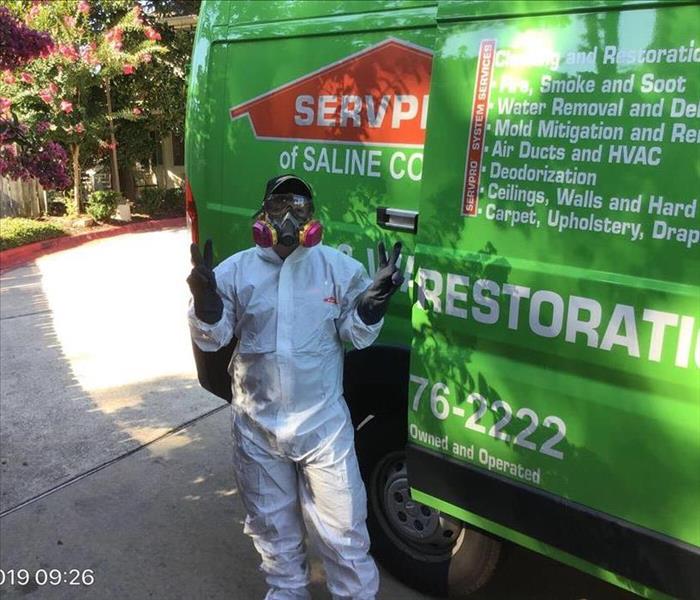 Carla is "ready for any size disaster!"
Carla is "ready for any size disaster!"
SERVPRO of Saline County and SERVPRO or Hot Springs is a part of a storm team that contributes when a storm event happens in the United States. In some events, hundreds of thousands of homes and businesses are damaged. They could be damaged from flooding by the storms, which creates hazardous conditions for the homeowners as well as our employees.
That’s why OSHA requires cleanup and restoration companies to wear Personal Protective Equipment (PPE). This will reduce the risk of exposure to harmful bacterial or chemicals. Mold growth is also common in buildings following flooding.
So, our employees are required to wear a respirator to protect their lungs. The suits they wear are airtight and waterproof to protect them from the dangerous waters. Goggles are also required to protect them from debris they might be removing from the buildings.

 24/7 Emergency Service
24/7 Emergency Service














